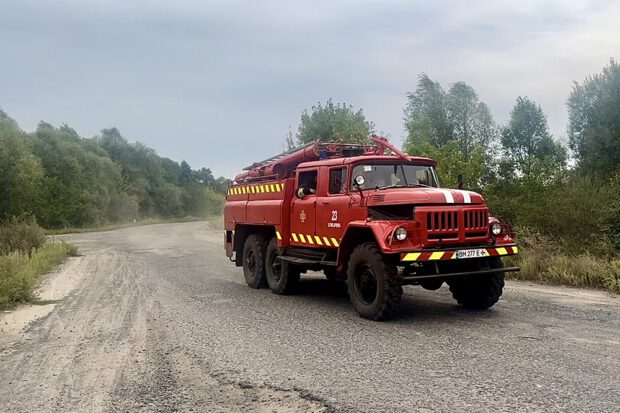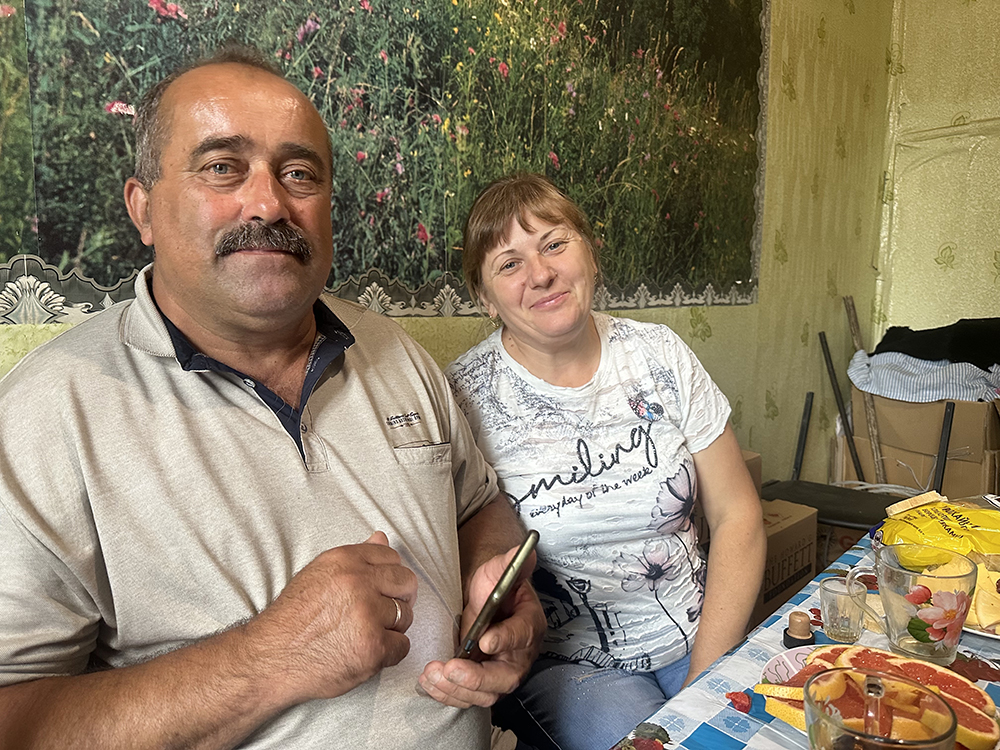
Lukashivka, a Ukrainian village in the Sumy region in northern Ukraine, located just 200 meters from the Russian border, was razed to the ground by guided aerial bombs in March 2024.
Oleksandrivka, Lukashivka, Dmytrivka, Shevchenkove and Bratenytsia belong to a county that has lately faced fierce Russian military retaliation. The attack came after a Russian Volunteer Unit, defending Ukraine against the Russian war of aggression, initiated an incursion into Russian Federation territory. In retaliation, the Russian military pummeled the border villages with guided aerial bombs and artillery.

All five villages lie in the “gray zone,” a two-kilometer area along the front line. Oleksandr Yakovenko, head of the county, is unable to assess the full scale of the damage due to security concerns. Each day, the villages endure massive diverse attacks but lately the worst threat comes from drones.
Kozinka, a Russian village walking distance across the border from Lukashivka, was also destroyed by the Russian army.
Drone attacks intensified following the Ukrainian military’s entry into the Kursk region of the Russian Federation, marking the beginning of a drone war. Up to 30 drones now fly over the area each day. Although Ukrainian military forces employ electronic warfare (EW) systems to jam signals and thwart drone attacks on civilians and infrastructure, many drones still manage to penetrate these defenses and reach their targets.
FPV (first-person view) drones are targeting farms and private homes, carrying explosives, grenades and incendiary mixtures in bottles that shatter and ignite the surroundings. Their primary objective is to set houses on fire, said Yakovenko, whose own house and yard in Oleksandrivka were destroyed by a drone fire during an artillery shelling in the last week of August.
The adjacent pine forest also suffered significant damage from the resulting blaze. In addition, two undetonated aerial bombs remain on the ground in Oleksandrivka.
“Nothing is left of my home,” said Oleksandr. “War is horrible.”
That same week, another house in Dmytrivka, another village continuously under drone attacks, also burned down. A drone dropped explosives on an outbuilding and the roof of the house, causing extensive damage.
“People still don’t want to leave their homes,” said Oleksandr. “Currently, in my six villages, there are 82 households still inhabited, totaling 147 people. All the children have been evacuated.”
Anatoly, in his 70s, originally from Oleksandrivka, had to relocate to the nearby village of Velyka Pysarivka.
“Our Oleksandrivka is no more,” Anatoly said. “It was erased from the face of the Earth in March 2024. The Russians used multi-launch rocket systems (MLRS), Grads, mortars, missiles and aerial-guided bombs. Whatever was left, they burned.
“Russian FPV drones drop grenades with fuel, which ignite upon impact. They’re doing the same in Velyka Pysarivka. Just the other day, a drone dropped such a device on a house, and it was reduced to ashes in eight minutes. This morning, two drones attacked us. The explosions were deafening! The drones swarm like flies.”
Vasyl Hryhorovych Kalchenko, the head of the villages of Yamne, Spirne, Kopiyki and Rozsoshi, also in the Sumy region, reports severe conditions in his area.
Yamne, the village closest to the border, just a few kilometers away, is constantly subjected to artillery fire, causing extensive damage. FPV drones are a frequent threat, and recently, a drone dropped explosives on a private house and a farm in Yamne, resulting in destruction by fire.
Vasyl said that forest fires are also widespread, with recent blazes in the Pysarevsky and Yamnensky forests. Extinguishing these fires is challenging due to mined roads and Russian drones that monitor and attack firefighters.
The risk of the outbreak spreading to the village is high, given the dry grass and the lack of recent rainfall. Although Yamne still has power and communication, all the children have been evacuated. Previously, a missile damaged the school, kindergarten and community center.
Despite the ongoing attacks, many residents have returned from evacuation to harvest crops and dig potatoes. Approximately 450 people were still living in Yamne at the end of September 2024, even though attacks never stopped. Drones attack at night: FPV drones drop explosives and Shahed drones fly over the district. During the day, there are artillery shelling and aerial bombings, mortars and missiles.
Forest Fires Weaponized
In the Sumy region, the Russian military targets not only villages and agricultural sites but also forests. Russian drone pilots attach napalm mixtures to FPV drones to start forest fires.
Oleg Marukha, director of Svesky Forestry of the State Enterprise “Forests of Ukraine,” reported that up to five fires break out daily due to drones dropping incendiary cans over forest areas, igniting fires upon impact. While mineralized strips are used to contain the spread where possible, military restrictions prevent access to all areas.
“Their goal is to ignite and destroy everything,” said a Ukrainian forces unit commander with the call sign Coliseum in an interview. “With the grass being dry, they aim to set it on fire, start large blazes, and destroy as much infrastructure as possible. Currently, we experience one or two fires every day, and there are up to 10 drones per five kilometers of the front line.”
Fighting fires near the front line is extremely challenging due to ongoing artillery, missile and drone attacks. In the smoldering pine and fir forests near Yamne, firefighters had to wait two hours before they could begin extinguishing a blaze due to a missile attack.
“The most likely cause of these fires is sabotage or shelling,” said Serhiy, a firefighter. “The entire Akhtyrsky region is ablaze, as are the Sumy and Kharkiv regions. It is unlikely that fires could start so frequently in the same areas by chance. It is more plausible that these fires are intentionally set, although there is a possibility that some may be ignited spontaneously by shelling.”
These forest fires are part of a broader pattern of environmental destruction in Ukraine. The Russian Federation’s military strategically employs environmental devastation as a tactic in its war of aggression against Ukraine. In the past two weeks, there have been 69 forest fires in northern Ukraine, burning a total of 136.87 hectares (about 338 acres). Of these, 47 were caused by the ongoing fighting and 31 occurred in the Sumy region in northern Ukraine, affecting 67.48 hectares.
Weaponizing the environment has broader effects and has led to severe power outages in Ukraine, with the looming risk of a nuclear catastrophe at the Zaporizhzhia nuclear power plant.
Ukraine is pushing to classify this environmental destruction as “ecocide” and for the International Criminal Court to recognize it as the Russian Federation’s fifth wartime crime, alongside genocide, crimes against humanity, aggression and war crimes. Legal experts believe Russian leaders could be prosecuted for these crimes if captured and found responsible, underscoring the potential for accountability on the international stage.
The deliberate destruction of civilian areas and natural environments is a key element of the Russian strategy, evident from previous conflicts in Chechnya, Syria and eastern Ukraine.
This approach aims to inflict maximum suffering and hinder recovery efforts. While providing aid and assistance in the recovery of affected areas is important, to effectively combat this tactic, the international community should support Ukraine, addressing the root cause of the war rather than just its symptoms.

